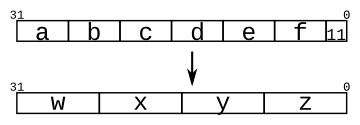hdlbits-Vector3
Vector3
Part selection was used to select portions of a vector. The
concatenation operator {a,b,c} is used to create larger vectors by
concatenating smaller portions of a vector together. 1
2
3{3'b111, 3'b000} => 6'b111000
{1'b1, 1'b0, 3'b101} => 5'b10101
{4'ha, 4'd10} => 8'b10101010 // 4'ha and 4'd10 are both 4'b1010 in binary
The concatenation operator can be used on both the left and right
sides of assignments. 1
2
3
4
5
6
7input [15:0] in;
output [23:0] out;
assign {out[7:0], out[15:8]} = in; // Swap two bytes. Right side and left side are both 16-bit vectors.
assign out[15:0] = {in[7:0], in[15:8]}; // This is the same thing.
assign out = {in[7:0], in[15:8]}; // This is different. The 16-bit vector on the right is extended to
// match the 24-bit vector on the left, so out[23:16] are zero.
// In the first two examples, out[23:16] are not assigned.
Practice
Given several input vectors, concatenate them together then split them up into several output vectors. There are six 5-bit input vectors: a, b, c, d, e, and f, for a total of 30 bits of input. There are four 8-bit output vectors: w, x, y, and z, for 32 bits of output. The output should be a concatenation of the input vectors followed by two 1 bits:

solution
1 | |